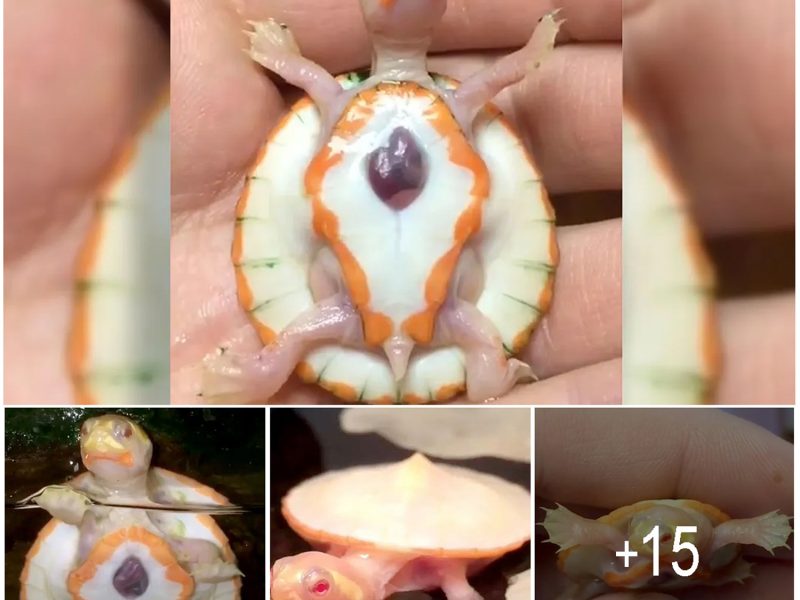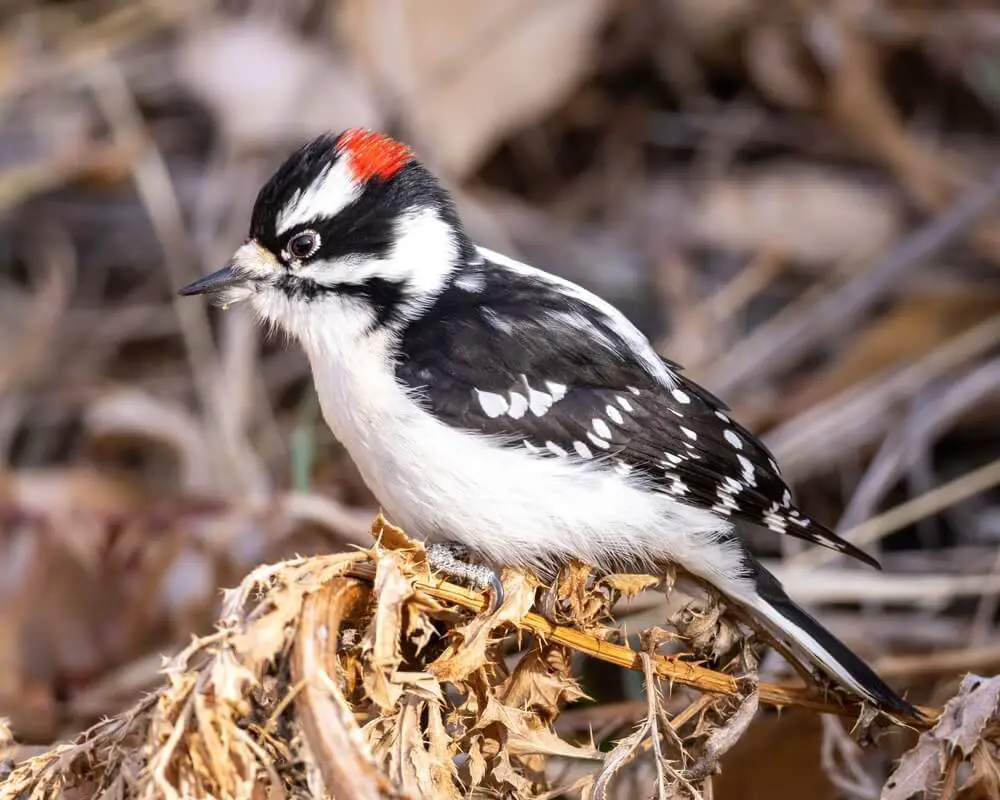
No matter where you are in the U.S., you should be able to see a downy woodpecker in the wild. Except for a very small southwestern area above the Mexico border, they live all over. They even extend through Canada and up to Alaska.
So, how can you attract these birds to your yard? Food and water are very important, as are keeping your feeders and bird baths clean. Provide plenty of areas to nest and roots, from trees to nest boxes.
Use these and the other tips below to make your yard inviting for downy woodpeckers.
9 Ways To Attract Downy Woodpeckers To Your Yard
1. Hang Bird Feeders Specifically For Woodpeckers
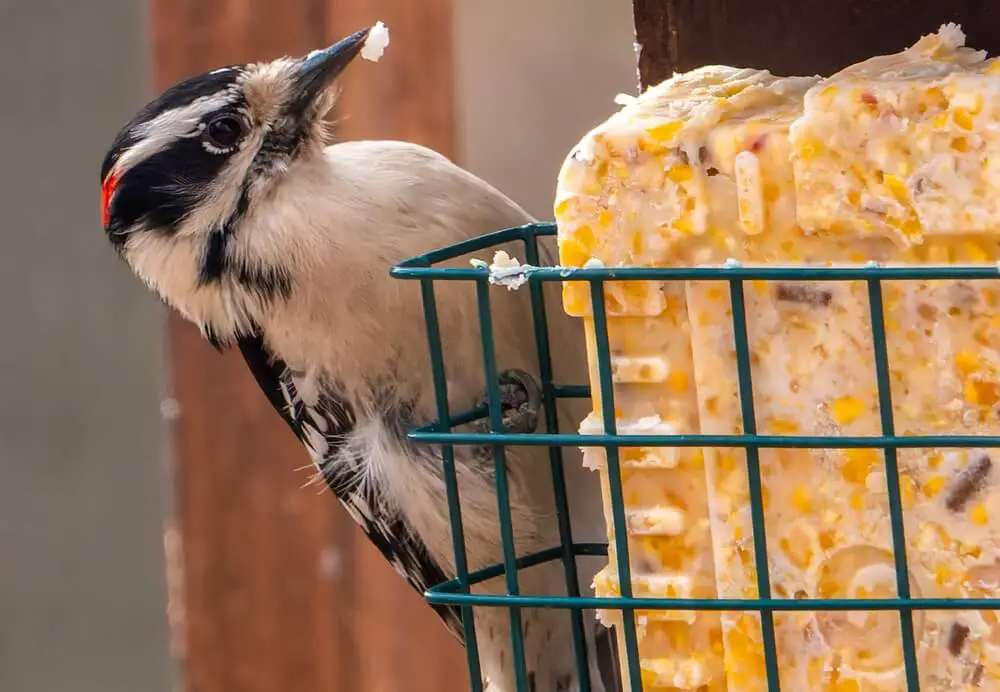
A bird feeder is the most common way for backyard birders to attract birds. It’s a consistent food source that requires little energy to access for the birds.
Try a platform feeder so the downy has a place to rest and room for its tail. They may be the smallest woodpecker in North America, but like other species, they do have somewhat long tails.
Suet cages are also a great choice, as it’s one of the downy woodpecker’s favorite foods.
2. Provide The Right Food For Downy Woodpeckers
Speaking of food, what you put into the feeders is just as important as where you hang them. Birds have different nutrition requirements, and the foods that provide them the most benefit are going to be their favorites.
Downy woodpeckers are very partial to suet. Suet is clarified kidney fat from an animal such as a cow or sheep. Suet that’s made for birds often includes seeds, nuts, and meals, and comes in the form of cakes or balls.
You can also offer your downys black oil sunflower seeds. These can be a part of the suet mix or on their own in a separate seed feeder.
Be sure to change out your food on a regular basis. Suet can go rancid, especially in warmer weather. Don’t put out more food than your woodpeckers can eat in a few days to prevent spoilage.
3. Avoid Using Pesticides
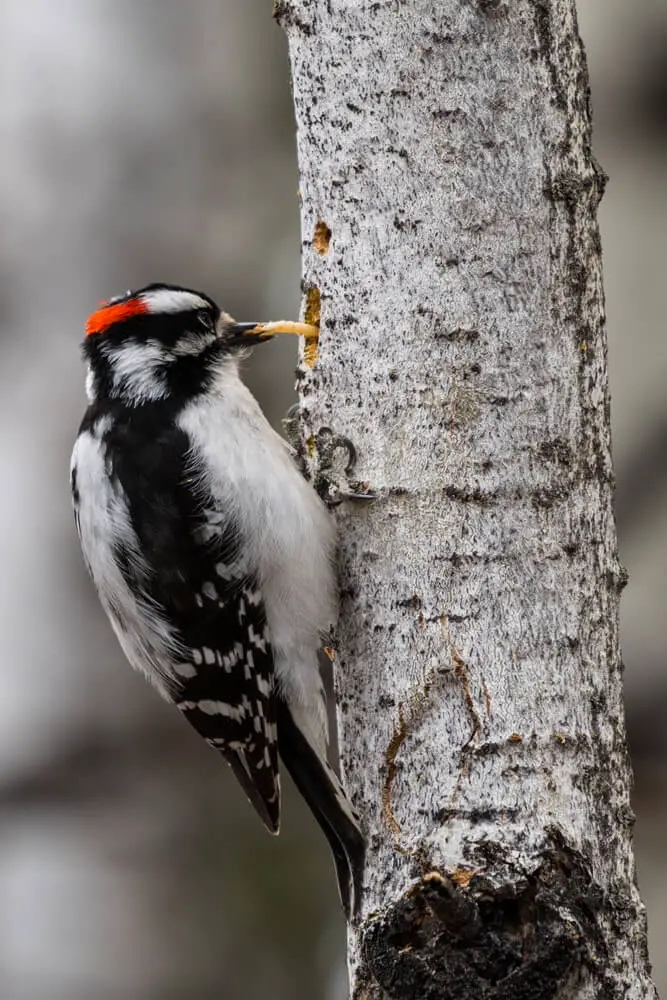
Although woodpeckers will flock to suet and seed feeders, in the wild they prefer insects. One of the main reasons a downy woodpecker drums on wood is to find the bugs living beneath the bark.
For this reason, you should avoid using harsh pesticides in your yard. You’ll be removing an important food source for the downy woodpecker, which may lead to them avoiding your yard.
In addition, certain pesticides are harmful to plants, important pollinators like bees, and even birds. Not only are you removing an important food source, but you can be harming the woodpeckers themselves, too.
4. Set Up A Bird Bath
Woodpeckers don’t just need food; they also need water for drinking and bathing. Not many people have a natural water feature right in their backyard, but it’s easy to provide an artificial source.
Set up a bird bath near your bird feeders to attract downy woodpeckers. However, make sure they’re not so close to the food that it can contaminate the water.
Traditional pedestal baths are a good option, but you can also put in a ground bath. They’re a little easier to clean, and you can even find some with heaters for the winter.
Change the water every couple of weeks, or if you start seeing algae growth. Downy woodpeckers like their water clean.
5. Make A Private Area For Downy Woodpeckers Only
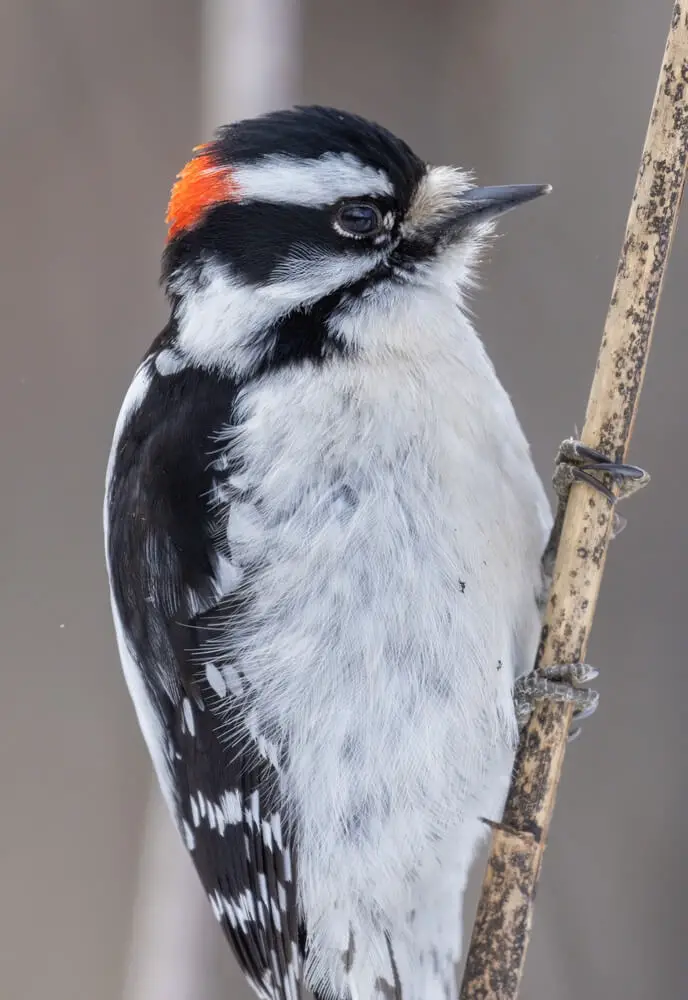
Downy woodpeckers love bird feeders and baths, but so do other birds. And downy woodpeckers are not very aggressive.
In fact, hairy woodpeckers target downys at a high rate while at feeders. Because of this, you should tailor the type and placement of your bird feeders for downy woodpeckers.
Place your woodpecker feeder in a secluded area where they won’t have to fight other birds as much. A great place is next to a tree trunk or bushes where woodpeckers naturally look for food and rest anyway.
You should also place your bird bath in the same area, as well as any nest boxes.
6. Build Nest Boxes
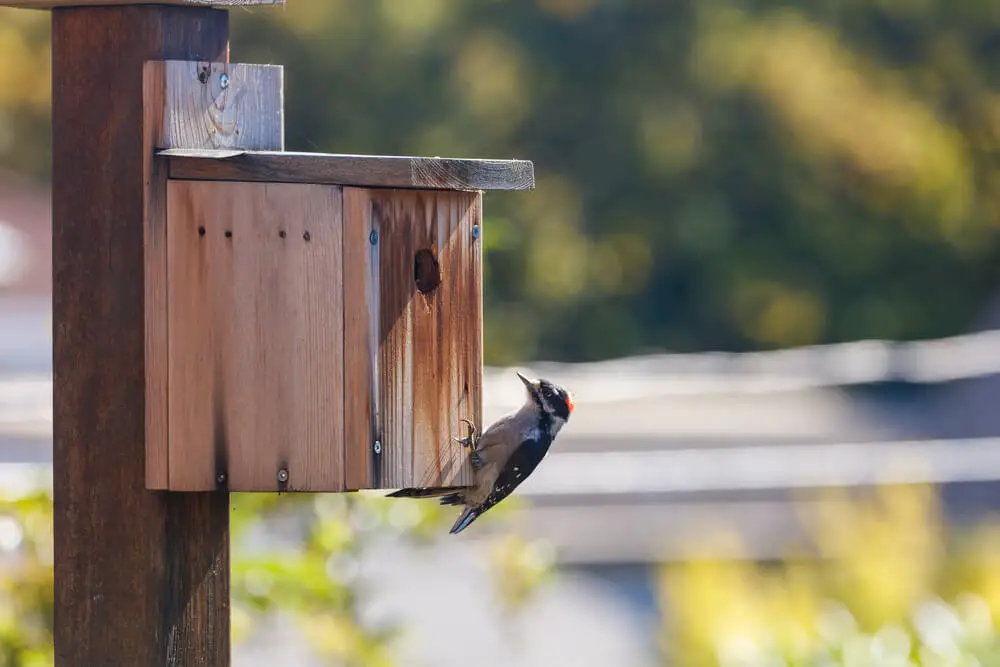
Downy woodpeckers are cavity nesters. This means that they build their nests in holes, usually ones they dig out themselves. They usually nest in the trunks of trees or even dead logs. Then, they line the cavity with wood chips.
If you don’t have many trees in your yard, you can build nest boxes to attract downy woodpeckers. A nest box is another term for a birdhouse.
You can build your own or buy a ready-made box. Be sure that the entrance is large enough for the woodpecker to fit inside. The average downy woodpecker is 5.5-6.7 inches long (14-17 cm).
You can fill the box with wood chips, too. This will deter other small birds from trying to nest there. It also lets the downy woodpecker follow its natural instinct to dig its own cavity.
7. Fill Your Yard With Trees
Trees, of course, take a long time to grow. But providing trees for downy woodpeckers doesn’t have to mean planting a bunch of saplings.
Instead, simply allow the trees already in your yard to flourish. Work with what you have to attract more woodpeckers.
There’s also nothing wrong with planting new trees, either, even if they may take some time to grow. It will be worth it to see all the new downy woodpeckers visiting.
8. Keep Your Yard Clean And Tidy
Your trees don’t have to grow completely wild, though, nor do your other flowers and shrubs. You can trim away dead branches as you need, which will provide a safer space for the birds.
You should also clean your feeders and water fixtures often. This doesn’t just mean changing out the food and water, although that should also be a priority. You also need to actually wash out and clean these fixtures.
Every two to four weeks, empty and thoroughly clean your bird feeders and baths. This will help prevent bacteria, mold, and algae growth that can be harmful to downy woodpeckers.
9. Don’t Cut Down Dead Trees
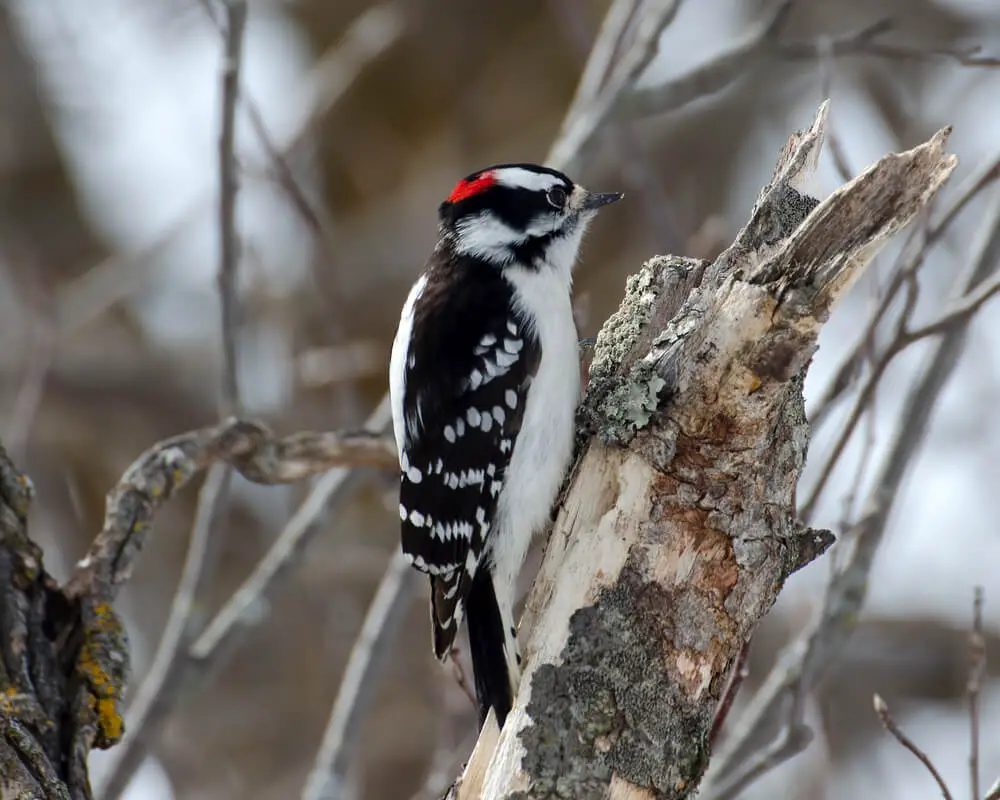
Everyone wants their backyard to look good. So, it’s natural to want to remove dead trees from your yard.
However, if the tree is not actually a hazard, consider leaving it, or only cutting away larger branches. Downy woodpeckers like drumming into dead trees for a number of reasons. First, the soft bark is easier to drill into than living trees.
Second, dead trees often have insects and larvae inside, which downy woodpeckers like to eat. Finally, dead trees are great spots to make cavities for nesting.
Frequently Asked Questions
What Do Downy Woodpeckers Eat?
Most of a downy woodpecker’s diet consists of insects. They drum into bark for beetle larvae, caterpillars, and ants. They’re also great at getting rid of garden pests like apple borers.
Plants like seeds and berries make up about one-fourth of their diet in the wild.
For backyard feeders, downy woodpeckers like suet, whether by itself or in a mix with seeds and meal. They also enjoy black-oil sunflower seeds and sometimes even peanuts.
Do Downy Woodpeckers Store Food?
Many woodpecker species “cache” their food, saving it for times when food gets scarce such as in the winter. Acorns are a common cache food, and the acorns that the woodpeckers forget actually help more trees grow.
Downy woodpeckers, though, do not store their food. This is possibly due to their extensive habitat range. They live all over the United States except for a small portion of the very southwesternmost part.
If food becomes scarce in one area, they’re more than capable of flying to more abundant areas for a time.
When Can I See Downy Woodpeckers?
Downy woodpeckers are year-round residents throughout most of the United States. This means you don’t have to wait for a specific season to see them in your yard.
Even during winter months, you can draw them to your yard by leaving out food and water.
In Summary
Downy woodpeckers are abundant across the U.S. So, by following these handy tips, you should have no trouble attracting these birds to your yard.
